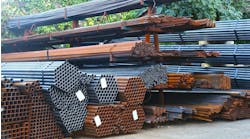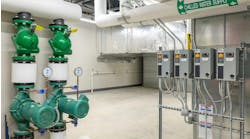Latest from Home
Sponsored
If you are not familiar with grooved mechanical piping systems, then chances are you haven’t experienced its positive impact on your bottom line. The grooved mechanical pipe joining method has been changing the way contractors like you do business for over 85 years, and yet this pipe joining method is still unknown or misunderstood in some corners of the commercial building industry.
Take a look at any commercial building’s fire protection system and you will see grooved mechanical systems are the preferred joining method, but take a look at the HVAC systems and often you will find different joining methods.
For those HVAC systems using alternative joining methods there exists the opportunity to save time and potentially increase profits by using grooved mechanical systems whenever possible. Mechanical contractors using grooved mechanical systems are able to complete new projects or retrofit work quicker, while keeping workers safe and contributing to the building’s overall sustainability goals. The multiple benefits gained through the use of grooved piping can easily become a competitive advantage, one absolutely worthy of a contractor’s attention. This article will discuss those benefits as they relate to the HVAC industry in detail.
Intro to grooved piping
The method of pipe joining is an important factor when designing and installing a piping system. Before choosing the joining method, it is important to consider several factors, including installation conditions, project schedule, available labor skills and tooling requirements, as well as other design and construction considerations. Each of these elements has an impact on which piping method will be the most suitable.
The primary methods of joining carbon steel and stainless steel pipe in the commercial market are welding, flanging, threading and, of course, grooved. Because every project has its own set of challenges, for each project one must consider the best possible solution for that application. In the case of mechanical systems, the opportunities to use grooved systems are numerous, but the concept/methodology, and the benefits they can provide are not widely known.
A grooved pipe joint is comprised of four elements: the grooved pipe, the gasket, the coupling housings, and the nuts and bolts. The groove is made by cold forming or machining a groove into the end of a pipe. A gasket encompassed by the coupling housing is wrapped around the two pipe ends, and the key sections of the coupling housing engage the grooves. The bolts and nuts are tightened with a socket wrench or impact wrench. In the installed state, the coupling housing encases the gasket and engages the grooves around the circumference of the pipe to create a leak-tight seal in a self-restrained pipe joint.
Grooved pipe joints can employ one of two basic coupling styles: flexible and rigid. Flexible couplings allow a limited amount of angular movement, while rigid couplings have angled bolt pads that produce a rigid joint and do not allow movement. There are benefits to both the rigid and flexible styles: A rigid coupling can be used wherever immobility in the pipe joint is needed, similar to a flanged or welded joint. Flexible couplings are capable of handling thermal expansion and contraction of the piping, differential settlement between structures, and seismic movement and, as such, are ideal wherever movement is likely, such as joints around equipment connections, changes in direction and building expansion or seismic joints.
Compressed schedules
Today, schedules are tighter and deadlines approach even faster, which is why managing construction schedules and meeting deadlines are not just priorities, but critical elements directly linked to project success and profitability. The ease and speed at which grooved mechanical piping systems are installed is how contractors can positively impact the bottom line and give themselves a competitive edge.
Grooved pipe joints are fast and easy to assemble because the gasket and coupling housings need only be positioned on the grooved pipe ends, and the bolts and nuts tightened to create a secure, leak-proof joint. No flame, heat or specialized tools are required, and some manufacturers provide grooved couplings that do not have torque requirements. Standard grooved couplings can be assembled up to five times faster than welded joints and up to three times faster than flanged joints. With the introduction, however, of Victaulic couplings featuring patented “installation-ready” technology, installation speeds are even better.
A standard coupling requires the coupling to be taken apart prior to assembling the joint, whereas a my firm’s installation-ready coupling remains assembled and is simply pushed on to the grooved end of a pipe, fitting, valve or accessory, and the bolts and nuts tightened. These new couplings install twice as fast as standard couplings, further enhancing productivity on the jobsite. Although the upfront materials cost of a grooved mechanical piping system may be greater than other pipe-joining methods, grooved systems offer a reduction in total installed costs because they reduce labor time, which is the largest cost variable in the field.
Safer jobsites
Not only is grooved piping fast and easy to install, it’s also safer than any other pipe joining method. Grooved mechanical piping systems are installed without the need for flame, eliminating the fire hazards typically associated with welding. Welding is one of the most dangerous industrial activities; its hazards include fire risk, electric shock, compressed gases and toxic fumes. As such, welding requires personal protection for the eyes, hands, feet and body. Welding activities also require a fire watch during and following the work, which can slow the construction schedule and increase costs.
The safety of installers on the jobsite is always of the utmost importance; however, it becomes even more critical during expansion and/or retrofit projects where buildings such as hospitals and schools may remain open and operational during construction. Grooved mechanical piping can decrease the risks to workers and, in retrofit or expansion projects, building tenants.
Environmentally friendly
Grooved joining technology is rooted in sustainability; its inherent qualities naturally make it environmentally friendly. Mechanical grooved piping systems significantly reduce or eliminate waste, emissions and noise pollution on the jobsite providing a safer and healthier environment.
A grooved mechanical pipe joint does not require the use of electricity during installation, reducing the draw on power resources. Pipes that are joined by welding or soldering require the use of vast amounts of electricity for prolonged periods of time. Additionally, indoor- and outdoor-air quality is preserved because there are no fumes or particulate matter to endanger workers or the environment. The elimination of these fumes reduces airborne pollution, leading to a cleaner environment as well as a safer jobsite during construction, maintenance and expansion.
Maintaining piping systems regularly, particularly HVAC systems — one of the biggest energy users within a building — keeps buildings operating efficiently. The sustainable nature of grooved mechanical piping systems can help reduce the environmental impact of structures, and increase efficiency throughout the life of the building.
Mechanical pipe joining systems make it more convenient to effectively maintain piping systems in structures, thereby reducing the deferral of maintenance and promoting operating efficiency and saving money.
With a union at every joint, grooved piping systems enable quick and simple routine maintenance, system expansion and retrofits. To access a system at a grooved joint, a worker simply loosens two nuts and bolts and removes the housings and gasket. A flanged joint, with its multiple bolts, is time-consuming to disassemble and then reassemble.
Finally, flexible couplings reduce the noise and vibration transmitted to the piping from pumps, chillers and other equipment. This vibration attenuation is achieved because the elastomeric gasket spans the pipe ends while being in contact with coupling housing, the key sections float in the grooves, the pipe ends are separated, and the ductile iron housing has a greater dampening coefficient. The use of flexible couplings around equipment connections can eliminate the need for vibration attenuation devices such as rubber bellows and braided flex connectors.
Many mechanical contractors have made the switch to grooved mechanical piping, when suitable, because it is quicker and easier to install, safer for the workers and the people close by and it provides long-lasting sustainable benefits, all of which can positively impact a contractor’s bottom line.
David L. Hudson is a senior engineer for Victaulic Co. Inc. He is a practicing mechanical engineer with more than 29 years of experience. He can be reached at [email protected].
Related Articles:
Victaulic provides piping systems for Shanghai World Expo buildings
Related Articles:
Victaulic to open distribution hub


